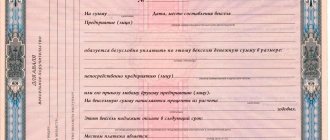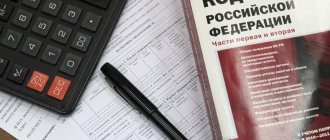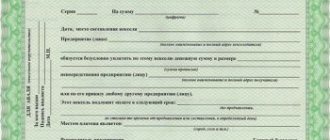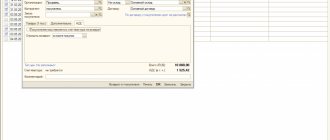Last modified: January 2021
When concluding a purchase and sale or supply agreement between legal entities, the provisions of the Law on the Protection of Consumer Rights do not apply, since it only applies to transactions of citizens made for personal needs. If the purchasing organization decides to return a low-quality product, then it should be guided by the norms of the Civil Code of the Russian Federation.
In the article we will look at the features of concluding a purchase and sale agreement between organizations, whether it is possible to return goods of proper or inadequate quality between legal entities, what is the procedure for returning money for goods and what to do if the return is refused.
Rules for returning goods between legal entities
The possibility of returning goods is usually determined by an agreement concluded between organizations. If the parties have not agreed on a special procedure for terminating the transaction, then the norms of the Civil Code of the Russian Federation are applied.
Returning goods of proper quality
Unlike the Law on the Protection of Consumer Rights, which applies to transactions made by citizens for household purposes, the Civil Code of the Russian Federation does not provide for legal entities the right to return quality goods. This is only possible if the parties have included a special condition in the contract.
Important! Part 1 of Article 454 of the Civil Code of the Russian Federation establishes the direct obligation of the buyer to accept and pay for the goods if they fully comply with the terms of the contract. In case of refusal of its obligations, the client risks receiving a claim from the seller. In addition, the contract may provide for the payment of a penalty for late acceptance of goods.
Example from judicial practice 1. Diesel-TS LLC purchased a fan, vibration isolator and air vent from Industrial Ventilation LLC. The buyer paid for the goods in full, after which the seller delivered it and installed it. In the process of checking the functionality of the equipment, it turned out that it did not provide ventilation to the room. In this regard, Diesel-TS LLC sent a claim to the seller demanding a refund for the low-quality product. Industrial Ventilation LLC refused to satisfy the claim, so the buyer was forced to go to court to protect its interests.
During the consideration of the case, the judge found that the parties entered into a purchase and sale transaction without a contract . The supply of ventilation equipment was carried out based on the buyer’s request. The plaintiff did not provide evidence that the parties agreed on the terms of the quality of the goods. The case file included an expert opinion, from whose conclusions it does not follow that the ventilation equipment was of poor quality. In this regard, the court refused to satisfy the claim of Diesel-TS LLC (Resolution of the Arbitration Court of the Volga-Vyatka District dated March 29, 2019 No. F01-985/20190).
Return of low-quality goods
With a low-quality product, the issue is much easier to resolve, since the law directly provides for the possibility of its replacement and return.
Thus, in accordance with Articles 475, 518 of the Civil Code of the Russian Federation, a buyer who has received low-quality products from the seller has the right to demand:
- proportionate reduction in cost;
- elimination of defects at the expense of the seller within a reasonable time;
- reimbursement of expenses incurred in connection with the correction of product defects.
The buyer may also ask to replace the product with a similar one of adequate quality.
If the product has significant defects, the buyer has the right:
- refuse the transaction and demand a refund;
- request a replacement product.
Additionally, the seller can be required to pay a penalty for failure to fulfill the terms of the contract.
Example from judicial practice 2. NPP Marat LLC purchased a muffle furnace from Votkinsk Repair Plant LLC under a supply agreement. Under the terms of the contract, the seller guaranteed that if the buyer complies with the temperature operating conditions in accordance with GOST 977-88, the guarantee for hidden defects will remain. After accepting the goods, it turned out that the company had transferred the goods to the buyer of inadequate quality, and therefore the company filed a claim with the seller.
The claim was not fulfilled, so NPP Marat LLC filed a claim in court for a refund of the money for the goods. When considering the case, a forensic examination was carried out, the results of which revealed that the muffle furnace had a defect in the form of a burn through the lower part and cracks in the material. The reason for the disadvantage is the uneven wall thickness of the product. The defect is hidden and cannot be detected during normal acceptance of the goods. Due to the fact that the seller’s guilt was established, the plaintiff’s demands were satisfied (Resolution of the Arbitration Court of the Volga-Vyatka District dated June 28, 2019 No. F01-2749/2019).
Terms for returning goods
Defects may be identified upon acceptance or subsequently during operation. In accordance with Article 477 of the Civil Code of the Russian Federation, the return period is 2 years , unless a different period is established by the agreement. You can also apply for termination of the contract during the shelf life of the product .
After the buyer contacts the seller, he must return the goods within the period specified in the purchase and sale or delivery agreement. If the parties have not determined it, then the refund is made within 30 days .
After the seller agrees with the buyer's claim, he is obliged to return the money within 10 days . A different period may be determined by the contract.
Return of goods from the buyer without VAT to the supplier with VAT
The procedure for returning goods to the seller with VAT from a buyer without VAT, who is on the simplified taxation system, that is, is not a VAT payer, depends on two reasons:
- the product is returned in its entirety;
- The product is partially returned.
Registration of the return of goods is entirely carried out by the seller in the purchase accounting book by registering the invoice he previously issued. Registration is carried out on the date of receipt of documents from the buyer and the goods themselves.
If the goods are returned in parts from a buyer who does not pay VAT, the seller is obliged to issue a corrective invoice. The amount of the adjustment invoice must correspond to the amount of the goods returned from the buyer.
If the goods were released without providing an invoice, that is, by using a cash register system, then the seller is obliged to return the money to the buyer by entering data into the purchase book, namely cash register details. In addition, the seller is obliged to register the receipt of the returned goods.
It is worth considering that even if the goods were returned by a VAT non-payer, the seller does not lose the right to deduct VAT. Thus, for tax accounting the reason for the return does not matter:
The procedure for returning money for goods between legal entities
Typically, the return of goods between legal entities is carried out on the basis of the procedure prescribed in the contract. The parties must comply with the claim procedure and try to resolve the conflict peacefully.
Let's look at the step-by-step instructions that the buyer must follow.
Step 1. Inspection of the goods upon acceptance and drawing up a report on identified deficiencies
One of the ways to accept goods is to follow the terms of the contract drawn up on the basis of Instructions P-6 and P-7 (resolution of the State Arbitration Court under the Council of Ministers of the USSR dated June 15, 1965 and April 25, 2966, respectively).
The buyer signs documents on acceptance of products only if they meet the contract requirements in terms of quantity and quality. It is advisable to create a commission in the organization consisting of different specialists who will weed out defective goods.
If defects are identified, they must be reflected in the acceptance documentation. In practice, the commission created by the buyer draws up an act that records the following information:
- date of acceptance of goods;
- composition of the acceptance committee;
- information about the parties to the agreement, the date of its conclusion;
- description of the goods being accepted;
- list of identified defects;
- decision to return the goods to the seller;
- signatures of the acceptance committee members.
If an expert was involved in the acceptance of the goods, then the name of the expert organization, data on the expert opinion and the results of the study should be indicated.
Step 2. Drawing up and submitting a claim
After drawing up the act, you must write a claim to the seller. The letter of claim must be sent to the legal address, as well as to the address specified in the contract, if it does not coincide with the legal address.
The claim should include information about the contract under which the delivery was made and about the defects identified upon acceptance of the goods. You should also determine a specific period for eliminating deficiencies.
Step 3. Conducting an examination of the quality of the product
If the seller does not agree that the goods supplied by him are of inadequate quality, a quality examination should be carried out. The buyer contacts an expert organization that has been accredited and specializes in the required type of research.
When appointing an examination, the expert involves the seller and the buyer. They have the right to be present during it and ask questions to the specialist.
Based on the results of the study, a conclusion is drawn up, which reflects the reasons for the occurrence of deficiencies, as well as the cost of losses.
Step 4. Submitting a repeated claim
After receiving the expert's opinion, the buyer makes a repeated claim, in which he describes the results of the study. The letter is drawn up according to the same template as given above.
In a repeated claim, it is necessary to set a new deadline for eliminating defects, and also warn the seller that in case of refusal, the buyer will go to court.
If any difficulties arise during the examination and preparation of the claim, we recommend that you contact a qualified lawyer. He will help you select a suitable expert organization and, after receiving the conclusion, issue a letter of claim.
Legislation
VAT is a tax that is part of the cost of purchased goods. Its size is 18% of the purchase price. The full name is value added tax, and it is actually paid by buyers. Citizens have begun to think more often about returns, but it is not available to everyone, but only to individual entrepreneurs.
- Article 78 of the Tax Code of the Russian Federation states that VAT refunds are not allowed to individuals, and only the one who pays it (that is, individual entrepreneurs) can receive it.
- Value added tax is not separately indicated in payment papers in accordance with clause 6 of Art. 168 of the Tax Code.
- There is also a mention of the refusal of payments to individuals in letters from the Ministry of Finance dated 02/09/2016 No. 03-07-14/6530 and 01/12/2016 No. 03-07-14/126.
- Those categories of citizens who are entitled to receive benefits must submit declarations. The inspector checks the form for two months, but in some situations the period increases to three (Clause 1 of Article 176 and Article 88 of the Tax Code of the Russian Federation).
- The list of documents required to obtain is specified in Article 165 of the Tax Code.
- According to paragraph 4 of Article 176, the taxpayer must write a statement.
- Paragraph 5 paragraph 4 art. 176 states that the tax authority is obliged to notify the applicant of its decision.
For reference! Some goods have a lower VAT percentage - 10%, and exported ones - from 7 to 25%.
What to do if a legal entity is refused to return goods?
In the event that it was not possible to issue a refund, the organization has the right to protect its interests in court. Disputes between legal entities are considered by arbitration courts according to the rules of the Arbitration Procedure Code of the Russian Federation.
The buyer must draw up a statement of claim and attach supporting documents to it. We recommend using the claim template below.
The following documents must be attached to the claim:
- purchase and sale (supply) agreement;
- invoices, invoices, delivery notes;
- payment orders for payment for goods;
- expert opinion;
- complaint and response.
Before applying to the arbitration court, one copy of the claim is sent to the defendant. The shipping receipt is attached to other documents.
After filing a claim, the court accepts it and schedules a trial. 3-4 months to resolve the dispute . At the last meeting, the judge makes a decision that is binding on the seller.
How to reflect the return of goods from the buyer in the VAT return
The procedure for displaying the return of goods from the buyer in the VAT return directly depends on the reasons for the return.
If the goods were not accepted by the buyer, that is, ownership of the goods was never transferred, then the proceeds from the shipped goods are displayed in the VAT return (line 010 - 020 of section 3 of the VAT return is completed). When returning goods, VAT is deducted on the amount of the returned goods - the basis is the supplier's adjustment invoice.
If the goods were nevertheless registered by the buyer, then it is necessary to carry out a “reverse sale”. Initially, it is necessary to display the proceeds from sales in lines 010 - 020 of section 3 of the VAT return, and upon the fact of returning the goods, it is necessary to display the VAT deduction, but only on the basis of the invoice drawn up by the buyer.









